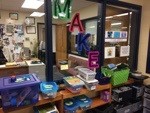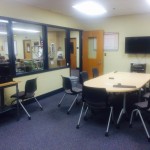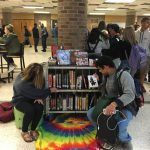 Over our winter break I was bemoaning my library statistics. I’ve had fewer than 50 classes visit the library, my circulation statistics are 1/2 what they were this time last year, my book displays are lame, and I’m floundering. What, exactly, is my role? I attended the AASL Conference in Columbus, I’ve researched, I’ve read books, I have done lots of talking about how libraries still matter, but what it actually “looks like” still confounds me! I’ve felt busy; even overwhelmed at times, but none of what I have been doing this year has felt quite right. Am I now just a manager of space? Do I simply supervise small groups of kids who don’t work well in a classroom? I don’t want to be a password resetter!
Over our winter break I was bemoaning my library statistics. I’ve had fewer than 50 classes visit the library, my circulation statistics are 1/2 what they were this time last year, my book displays are lame, and I’m floundering. What, exactly, is my role? I attended the AASL Conference in Columbus, I’ve researched, I’ve read books, I have done lots of talking about how libraries still matter, but what it actually “looks like” still confounds me! I’ve felt busy; even overwhelmed at times, but none of what I have been doing this year has felt quite right. Am I now just a manager of space? Do I simply supervise small groups of kids who don’t work well in a classroom? I don’t want to be a password resetter!
I recently did 2 presentations that have really helped me clarify what I want for my students and my library. One presentation was for my staff during a flexible PD day about my 21st Century vision for the library. It was somewhat well attended and several collaborations have come from it. (blog posts to follow) The other was for the Alpha Iota chapter of ADK, a teaching sorority in my county, about Makerspaces. Something about standing up in front of others and advocating for my students, my library and myself has made me feel much more confident and a little inspired about what @Rocket Library has to offer our students and staff.
I have a colleague who is a wonderful librarian herself. Our pact has been to support each other through what we knew would be a really different year. Both of our schools have gone 1:1. This rollout has teachers thinking differently about how they teach, how students learn, where they learn, and how they’re assessed. This change is BIG! Teachers aren’t thinking about library stuff. They’re in survival mode. How can I get them to think about me and what I have to offer when they are bogged down with WiFi issues, Google Hangouts drama and Piktochart! One tactic has been to provide things in the library they CAN’T get with a Chromebook or in a classroom. I have comfy chairs, a flat screen television, dual monitors on my desktops, a 3D printer, a color printer. I have a MAKERSPACE! “What’s that?” they ask. 🙂


So I’ve started to try to redefine (for me) what a successful library looks like. I’m currently using an iPad and the app INSIDE for individual students to sign in and out. While it’s not completely accurate, (Adolph Hitler signed in every day for a week), I had around 7,000 students in and out of the library between August and December. Some come here instead of going to lunch, Some come because they forget their computer and need to use a desktop. Some come because they are driving their teacher crazy and they “work better” in the library than in the classroom. Others come because they are doing something that requires unique space only found here. They are recording a podcast and need a digital voice recorder, a quiet room and audacity. Some come because they want to use the flat screen television to project a Google Slideshow. Some come because the dual monitors allow them to keep a Word document and a website open at the same time. The key is they are still coming. I need to continue thinking of ways to measure success that go beyond circulation statistics. I need to continue reaching out to teachers in new ways. I need to publicize any little successes I have because I’ve found that triggers more awareness and thinking about connecting with the library. Most importantly, I need to keep thinking about my students and how I can create meaningful learning opportunities for them that reach far beyond the classroom. To quote David Lankes, “it’s about people”.






